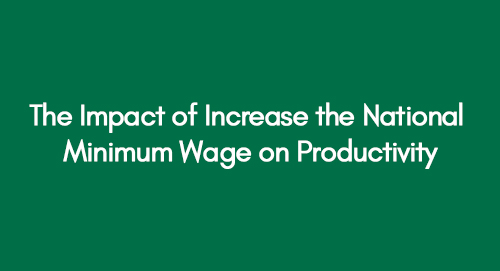
Use of Building Information Modeling (BIM) in Construction Industry | A Study with Engineering Perspective
December 21, 2020
Construction Engineering Dissertation Topics | List of 200 Topics for 2025
December 22, 2020Raising the national minimum wage can have an effect on how much work is done. When it goes up, some workers may work harder or be more motivated, but it can also make businesses cautious about hiring and lead to changes in how things get done.
The concept of the National Minimum Wage (NMW) and its implications for companies or nations significantly impact the performance of small or large operating firms (Georgiadis, 2006).
Chapter 1: Introduction
Many theorists believe that this regulation has increased the labour cost in small firms and, in return effect positively an organisation’s overall performance (Wincenciak, 2010).
The relationship between wage and productivity will be described in this study through Wage Hypothesis Theory (Curtiss, 1963). This study will explore different views presented by this theory on how firms can maximise their profit through employment development.
Research Aims and Objectives
The present study aims to discover the effect of Minimum National Wages on a firm’s production. The focus of the study is to explore the underlying relationship between National Wages and employee performance and how this relationship contributes to the increases or decreases in a company’s overall efficiency and performance. Keeping in mind the above-mentioned facts, the following aims and objectives are drawn for the study.
The present study aims to discover:
- The relationship between Minimum National Wage and firm productivity.
- The effect of the Minimum National Wage on a firm’s behaviour in different economic conditions.
- The strategies that companies adopt in influencing firms' behaviour and productivity.
- How companies are incorporating technology to substitute labour to reduce expenses and increase productivity.
The present study will focus on studying the above-mentioned objectives of the research.
Chapter 2: Literature Review
Much work has been done in examining the impact of the National Minimum Wage on employees’ performances. However, how this impact affects organisational performance and productivity is still to be discovered in detail (Aslam, 2003). Many researchers claim that the relationship between Minimum Wages and the behaviour of employees is neutral; therefore, the direction was shifted to explore its effect on a firm’s productivity and behaviour (Portes, 2015). The results of those researches indicated that the effect of Minimum wages on the firm’s behaviour is a strong area to be studied as it determines the company’s productivity and operations.
Two studies on the Impact of National Minimum Wages were carried out by Draca et al. and Galindo-Rueda Pereira in Britain, exploring the impact of NMW firm’s productivity. The findings of the study reveal that the implication of NMW has resulted in decreasing the profitability of many firms, especially small firms. The results suggested that in terms of long-term productivity, this concept might have a significant effect on the behaviour of employees, but they don’t seem to be beneficial for achieving long-term targets of productivity (Bondibene & Riley, 2013).
However, the results of these studies cannot be applied universally as there are limitations to their studies. They were carried out within a small time frame, and the data comprise industrial information. Generally, it was found that by increasing labour productivity, the companies raise their capital, which positively affects their overall industrial performance. (Wincenciak, 2010). There is still a rift between theorists as some think setting National Minimum Wages will affect productivity.
In contrast, some think no such significant relationship exists between these two variables. (Relly, 2013). The subject of how the National Minimum Wages affect the employment system and the firm’s productivity still needs to be discussed and explored more.
National Minimum Wage and Firm’s Response
The incorporation of the National Minimum Wage has helped to increase the labour cost by raising the earnings of low-paid workers (Wage, 2014). However, there are not many studies available to support the fact that NMW affects the overall operating behaviour of employees. On the contrary, many small firms react negatively to this change as their resources do not help them increase their employees' wages. Thus, they have to cut their overall profit margins. Several researches had been conducted after the introduction of NMW in 1999 to analyse the relationship of National Minimum Wages with employee's and firm's productivity (Wincenciak, 2010).
The prominent among them was research carried out by Rabecca Riley and Chaira Rozza. Their findings indicate that the insinuation of NMW has resulted in high labour costs in small firms since 2000. However, the employees were still paid on average during the recession time. In addition, they also report that small firms also responded to these changes as they claim to add more value per employee to raise their efficiency and productivity. (Wilson, 2012). Many researchers believed that the primary purpose of this change was that the companies wanted to increase their capital and production outputs by investing in their labour force. This investment helps to utilise their full potential, ultimately benefiting the company.
Strategies to Improve Company’s Productivity
Despite the circumstances or situations, the main goal of an organisation is to incorporate strategies that result in increasing the overall productivity. The initiative of Minimum Wages was a step to motivate the workers to achieve their full potential, which affects their performance and the firm’s productivity (Bewley, 2015). In addition to incorporating NMW, there are other strategies that companies can follow to increase the output of their workers, such as work speed, quality and work volume (Portes, 2015). These include:
- Providing incentives and bonuses to their employees help them retain their efficient workers and motivates them to work towards the organisational goals. In addition, companies hire employees who are skilled and experienced and motivate them through incentives. They practice effective retaining policies in their HR department for continuous and effective performance.
- Companies undergo different training and education programs for their managers to enhance their leadership skills to effectively lead their team towards organisational goals.
There are many other strategies which will later be discussed in the study.
Chapter 3: Methodology
The methodology chapter will include the data collection techniques that will carry out to collect the relevant data. In this type of research based on case studies, the methodology will consist of a summary of the literature and the case studies that will be explained in the research. Primary research may not be conducted as, at this moment, the researcher feels that sufficient secondary data is readily available to address the research questions.
Chapter 4: Findings and Analysis
The findings and analysis chapter will present the significant findings and results of the study. They will be achieved through extensive literature review and review of case studies in this field. It is expected that research findings will justify the objectives set earlier for the study. There might be a chance that the result will vary a little from the research objectives due to the different circumstances in which the research was carried out. However, the aim of the research is to relate the results with the research hypothesis and objectives.
Chapter 5: Discussions and Conclusions
Following the finding and analysis chapter will be the Discussion and Conclusion chapter. This chapter will include the researcher’s views on the study’s findings and results. All the discussion will be done in the light of previous researches, and references will be provided to support the research’s findings. In the end, a brief conclusion will be presented to summarise the research. This chapter will clearly outline the relationship between productivity and Minimum National Wages.
References
Aslam, N., 2003. Level of Real Wages and Labour Productivity in the. The Pakistan Development Review, XXII(4), pp.284-87.
Bewley, H..P.J., 2015. Press Release: The Impact of the National Minimum Wage on Productivity, Business Performance and Employment. National Institute of economic and Social Sciences.
Bondibene, C.R. & Riley, R., 2013. The Impact Of The National Minimum Wage On Firm Behaviour. National Institute of Economic and Social Research.
Curtiss, W.M., 1963. Foundation of Economic Education. [Online] Available at: http://fee.org/freeman/wages-and-productivity/ [Accessed February 2016].
Georgiadis, A.P., 2006. Is the Minimum Wage Efficient? Evidence of. Bristol: Centre for Market and Public Organisation.
Portes, J., 2015. [Online] Available at: http://www.niesr.ac.uk/media/press-release-impact-national-minimum-wage-productivity-business-performance-and-employment#.VpIS_vkrLIV [Accessed February 2016].
Relly, R., 2013. The Impact Of The National Minimum Wage On Firm Behaviour. National Institute of Economic and Social Research.
Wage, N.M., 2014. Economics.Help. [Online] Available at: http://www.economicshelp.org/labour-markets/minimum-wage/ [Accessed February 2016].
Wilson, M., 2012. The Negative Effects of Minimum Wage Laws. Washington: CATO Institute.
Wincenciak, L., 2010. Lecture 3 Efficiency wages. [Online] Available at: http://coin.wne.uw.edu.pl/wincenciak/docs/makro_zaawansowana/lecture_3.pdf [Accessed February 2016].
Get 3+ Free Dissertation Topics within 24 hours?


























